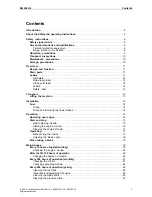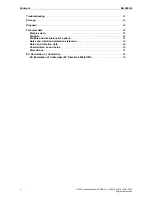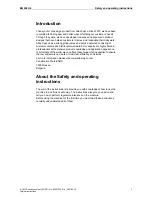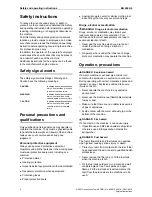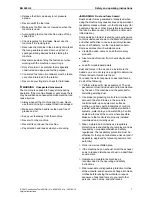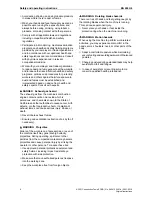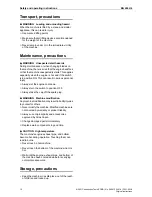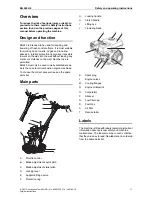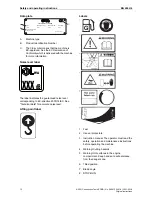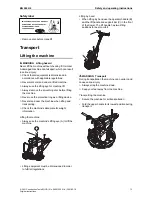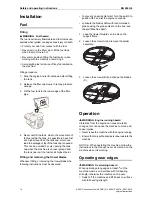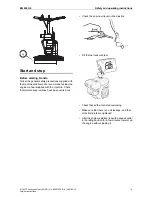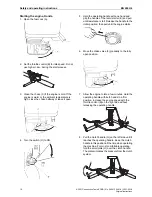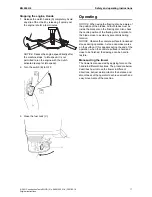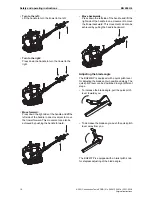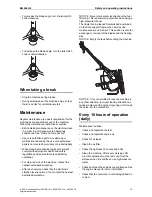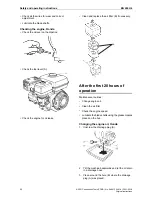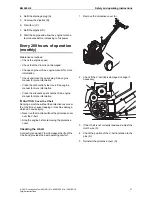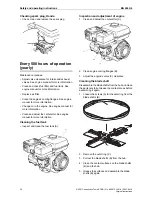
►
Release the filler cap slowly to let pressure
escape.
►
Never overfill the fuel tank.
►
Make sure the filler cap is screwed on when the
machine is used.
►
Avoid spilling fuel on the machine, wipe off any
spilled fuel.
►
Check regularly for fuel leaks. Never use the
machine if it is leaking fuel.
►
Never use the machine in the proximity of material
that can generate sparks. Remove all hot or
spark-generating devices before starting the
machine.
►
Never smoke when filling the fuel tank or when
working with the machine or servicing it.
►
Only store fuel in a container that is specially
constructed and approved for the purpose.
►
Consumed fuel and oil containers must be taken
care of and returned to the retailer.
►
Never use your fingers to check for fluid leaks.
WARNING Unexpected movements
The machine is exposed to heavy strains during
operation. If the machine breaks or gets stuck, there
may be sudden and unexpected movement that can
cause injuries.
►
Always inspect the machine prior to use. Never
use the machine if you suspect that it is damaged.
►
Make sure that the handle is clean and free of
grease and oil.
►
Keep your feet away from the machine.
►
Never sit on the machine.
►
Never strike or abuse the machine.
►
Pay attention and look at what you are doing.
WARNING Dust and fume hazard
Dusts and/or fumes generated or dispersed when
using the machine may cause serious and permanent
respiratory disease, illness, or other bodily injury (for
example, silicosis or other irreversible lung disease
that can be fatal, cancer, birth defects, and/or skin
inflammation).
Some dusts and fumes created by compaction work
contain substances known to the State of California
and other authorities to cause respiratory disease,
cancer, birth defects, or other reproductive harm.
Some examples of such substances are:
●
Crystalline silica, cement, and other masonry
products.
●
Arsenic and chromium from chemically-treated
rubber.
●
Lead from lead-based paints.
Dust and fumes in the air can be invisible to the
naked eye, so do not rely on eye sight to determine
if there is dust or fumes are the air.
To reduce the risk of exposure to dust and fumes,
do all of the following:
►
Perform site-specific risk assessment. The risk
assessment must include dust and fumes created
by the use of the machine and the potential for
disturbing existing dust.
►
Use proper engineering controls to minimize the
amount of dust and fumes in the air and to
minimize build-up on equipment, surfaces,
clothing, and body parts. Examples of controls
include: exhaust ventilation and dust collection
systems, water sprays, and wet drilling. Control
dusts and fumes at the source where possible.
Make sure that controls are properly installed,
maintained and correctly used.
►
Wear, maintain and correctly use respiratory
protection as instructed by your employer and as
required by occupational health and safety
regulations. The respiratory protection must be
effective for the type of substance at issue (and if
applicable, approved by relevant governmental
authority).
►
Work in a well ventilated area.
►
If the machine has an exhaust, direct the exhaust
so as to reduce disturbance of dust in a dust filled
environment.
►
Operate and maintain the machine as
recommended in the operating and safety
instructions
►
Wear washable or disposable protective clothes
at the worksite, and shower and change into clean
clothes before leaving the worksite to reduce
exposure of dust and fumes to yourself, other
persons, cars, homes, and other areas.
7
© 2051 Construction Tools EOOD | No. 9800 1224 01b | 2051-05-18
Original instructions
Safety and operating instructions
BG 240 H4



